Why We Must Pass the Climate Change Superfund Act Before the End of Legislative Session
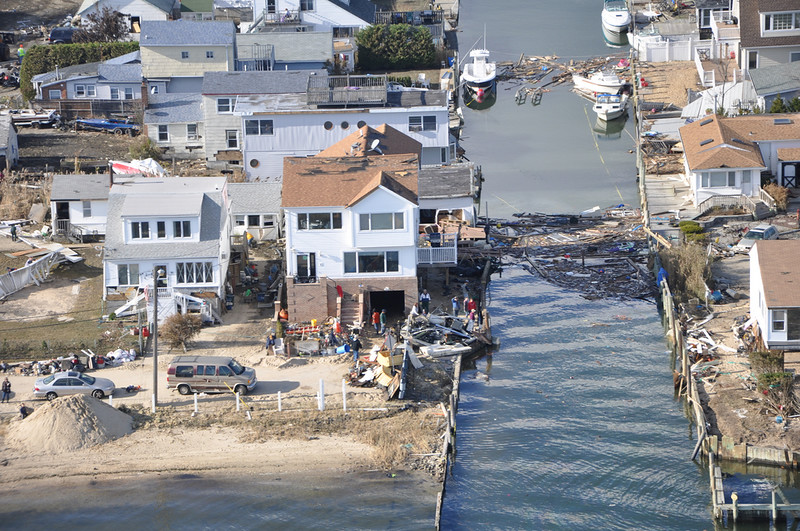
Flooding on Long Island (photo: Governor's Office)
Climate change is eating Long Island away, and is projected to raise our sea level to more than 50% higher than the global average. If those estimates are correct, that means large portions of Jones Beach will disappear by 2050, the north and south ends will become their own islands by 2080, and Fire Island will almost completely wash away by the end of the century.
Protecting Long Islanders’ homes from this kind of irreparable climate damage is possible – but climate change is already costing taxpayers an arm and a leg. It is a cost that we should not have to pay.
There’s a solution to this problem making its way through the New York State Legislature right now - a plan that would take the burden off of taxpayers and put those who created this climate catastrophe on the hook instead. That bill is the Climate Change Superfund Act. The act makes the worst corporate climate polluters – Big Oil – pay. It should be on Albany’s “must do” list as we head into the last days of the legislative session.
Just this year, New Yorkers statewide have been forced to pay around $800 million for projects related to climate damages and resiliency projects. It’s only going to get worse.
The Long Island Regional Planning Council is projecting $75 to $100 billion out of taxpayers’ pockets for new roads and other infrastructure improvements, thanks to worsening storms and sea level rise. That’s right – tens of billions of taxpayer dollars to elevate our streets (where they have been washed away from intense storms), build new bridges, and upgrade our septic systems and storm drains to protect them against future flooding.
Many of us who live on Long Island have already experienced this kind of flooding. We need this infrastructure to protect against tragedies like Hurricane Sandy, which took 13 lives and damaged or destroyed 100,000 homes. Suffolk County experienced seven natural disaster declarations in the last decade — the most of any county in the state. And while we have to suffer and pay for these consequences, Big Oil companies are getting richer.
The top Big Oil companies are on track for a second consecutive year of record profits. Across the globe, Big Oil companies are performing much better than expected this year, following last year’s record-breaking profits totaling $376 billion. These companies want you to believe that they’re investing in clean and renewable energy sources. Don’t buy the smoke and mirrors.
They fund climate science denial while pushing greenwashing advertising. Big Oil wants us to believe they have our wellbeing at heart, but their actions racked up a tab of $5.4 trillion in climate damages worldwide over just 26 years. Even worse, they knew that they were driving the climate catastrophe as early as the 1970s. And now, even after all of this has come to light, they evade any sort of real accountability.
We’re all impacted by climate change, but Black, Latino, Asian, and low-income communities bear the brunt of it. Natural disasters aren’t just the weather themselves — they’re worsened by social, political, and economic stressors. Low-income communities experience greater challenges evacuating due to the cost of transportation and relocation. But when people stay, they experience increased health risks including contaminated water and interrupted access to medical care and food. On top of that, because of the increased risk of asthma, heart disease, and other chronic health problems that low-income and communities of color experience (also because of other environmental injustice), these communities are especially vulnerable to storm hazards.
And of course, after the flood, cleanup is expensive and leads to increased debt, partly because people in poverty are less likely to have flood insurance. According to the Urban Institute, after four years, a medium-sized disaster causes a 31-point decline in credit scores for people living in communities of color, whereas people living in white communities only experienced a 4-point decline.
On Long Island, we already know what it’s like to pay more than our fair share. We pay through the nose in property taxes. And now we have to deal with the exponentially increasing risk of flood damage to our homes because of a mess we didn’t make — on top of raised taxes for climate change infrastructure? It’s criminal.
Experts have already proven that making polluters pay for their fare share of this mess won’t result in those costs being passed onto consumers. We can’t afford to pay for climate change, and we shouldn’t have to. Let’s make corporate climate polluters pay by passing the Climate Change Superfund Act.
***
Assembly Member Michaelle Solages represents New York’s 22nd District. On Twitter @SolagesNY.
***
Have an op-ed idea or submission for Gotham Gazette? Email This email address is being protected from spambots. You need JavaScript enabled to view it.
Hundreds of Units of Affordable Housing in Queens at Risk if Albany Fails to Act

Housing in focus (photo: Michael Appleton/Mayoral Photography Office)
The inclusive, affordable, and transformative redevelopment of the Astoria waterfront is at risk of falling apart without decisive action from the State Legislature.
Last year, the City Council and Mayor Eric Adams approved the rezoning for Halletts North; a project that is set to transform a long-dormant site on Astoria’s waterfront into a mixed-use building with nearly 1,400 homes for families of all sizes, including 335 apartments at deep affordability levels.
This project’s approval was a collaborative effort. City Council Member Tiffany Cabán negotiated for deeper affordability to better meet Astoria residents’ housing needs. Additionally, the developer agreed to set aside optimal space within the completed project for local nonprofits, such as Zone 126 and Urban Upbound (an organization that I co-founded 19 years ago) to offer essential programming to community members. To help address some of the community’s immediate needs, the developers also allocated $1 million to the Astoria Houses for the residents to use at their own discretion.
Unfortunately, the build-out of Halletts North is facing delays largely due to supply chain issues that have affected much of our city’s construction industry. Completing the construction of Halletts North by the deadline for projects already vested in the old 421-a tax abatement program for affordable housing development — by June 2026 — will be nearly impossible.
In the few days before the end of legislative session, there is still time for Albany to take action that would clear the way for the completion of Halletts North. The deadline to complete construction on projects vested in 421-a could be extended beyond 2026, and this extension could be granted exclusively to projects that achieve the deepest levels of affordability associated with the old 421-a program. This nuanced approach would ensure that the time and efforts of the Astoria residents who support Halletts North are heard and honored.
At Urban Upbound, our mission is to provide residents of public housing and lower-income communities with the tools they need to achieve economic independence and break cycles of poverty. Zone 126 works to build strong educational pipelines that close achievement gaps for Black, Latino, and low-income students in Western Queens. The agreement to construct Halletts North would provide these two organizations with 10,000 square feet of space in the new development, which we plan to use for small business and job-incubator programs. We can create an inspiring and innovative space where residents, especially those from the nearby Astoria Houses, can hone their workforce, academic, and entrepreneurial skills as well as receive one-on-one financial counseling.
We face a dramatic housing crisis, one that dominates the headlines every single day. Without new deeply affordable housing, this crisis will only get worse. Projects like Hallets North present Albany with an opportunity to support the efforts of local communities working to leverage development for the greater good.
***
Bishop Mitchell G. Taylor is the CEO & Co-founder of the nonprofit Urban Upbound.
***
Have an op-ed idea or submission for Gotham Gazette? Email This email address is being protected from spambots. You need JavaScript enabled to view it.
Cut the Trash: Time for New York to Pass the Waste Reduction and Recycling Infrastructure Act
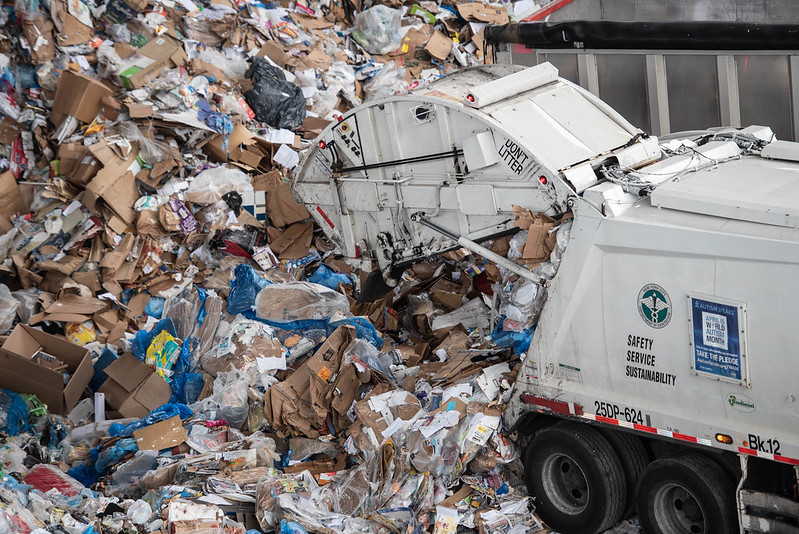
Waste (photo: Michael Appleton/Mayoral Photography Office)
Say you order a pair of shoes online. The oversized box comes in; you cut it open to reveal more packaging and the shoebox, and then you finally get to your shoes, which are surrounded by a pile of cardboard, paper, and plastic. You’re a thoughtful, environmentally conscious New Yorker, so you take the gargantuan box out to the curb for recycling and throw out the extras that you can’t recycle.
Here’s the thing, though – your online retailer didn’t have to send you a box three times bigger than your shoes, and they didn’t have to fill it with hard-to-recycle plastic. They can tackle this problem on the front end instead of making it your responsibility to recycle or dispose of their wasteful packaging. That’s why it’s so important that Governor Hochul and legislative leaders pass the Waste Reduction and Recycling Infrastructure Act by the end of this state legislative session, so those companies will have to step up to the plate and take responsibility for their packaging.
If passed into law, cities and taxpayers that spend hundreds of millions of dollars on processing packaging and paper waste would see responsibility and financial burden shift to the companies responsible for making the products to begin with. It would incentivize those companies to use fewer materials and make those materials easier to recycle – all while providing desperately needed reimbursement to municipalities processing those products.
Throughout New York State and New York City, local communities, governments, and conservation organizations are working tirelessly to reduce the massive ecological footprint of over 15 million tons of statewide waste per year. But individual responsibility only goes so far. The urgency of the climate crisis demands systemwide waste diversion and realignment of incentives for manufacturers. This bill achieves that by requiring packaging and distribution companies to reduce their waste or foot the bill. This law alone is estimated to reduce landfill waste from New York City by 600,000 pounds every day – the same weight as about 344 trucks.
Extended producer responsibility (EPR) policies like this one aren’t new. They are utilized around the globe to shift the financing of waste management from the taxpayer to the producers of waste. EPR programs encourage sustainable product design and increase recycling through incentivized fee structures, recyclability targets, convenience requirements, and strong oversight. California, Maine, Colorado, and Oregon have passed similar laws, incentivizing companies to create more environmentally sustainable packaging products. These have boosted recycling rates in some areas where laws have been well-implemented to as high as 70%.
New York State already has EPR laws in place for paint, electronics, rechargeable batteries, and pharmaceuticals. As a result, our state has seen significant increases in diversion of these materials from landfills and saved millions of dollars. Last year, thanks to the work of the Senate and Assembly, we were able to get the Extended Producer Responsibility bill for carpets passed and signed into law by Governor Hochul.
New York City could receive more than $150 million in revenue generated by this bill, which would cover about 30% of the city’s residential waste stream. This is a win for the city and the state; other municipalities statewide are estimated to receive $300 million.
Similar versions of this legislation have been on the table since 2020, but have been pushed out of the budget and never voted on later in legislative session. Every year we delay, New York City taxpayers foot that $150 million bill.
Municipalities cannot afford to leave money on the table and our environment cannot continue to bear needless waste. I urge the Governor, Speaker Heastie, and Leader Stewart-Cousins to come to the table to get waste reduction for packaging and paper done this year.
***
Julie Tighe is President of the New York League of Conservation Voters, NYLCV. On Twitter @julietighe17 & @NYLCV.
***
Have an op-ed idea or submission for Gotham Gazette? Email This email address is being protected from spambots. You need JavaScript enabled to view it.
A Closer Look at 2022 Gubernatorial Election Results Shows Why New York Democrats Must Pay Better Attention to Latino Voters
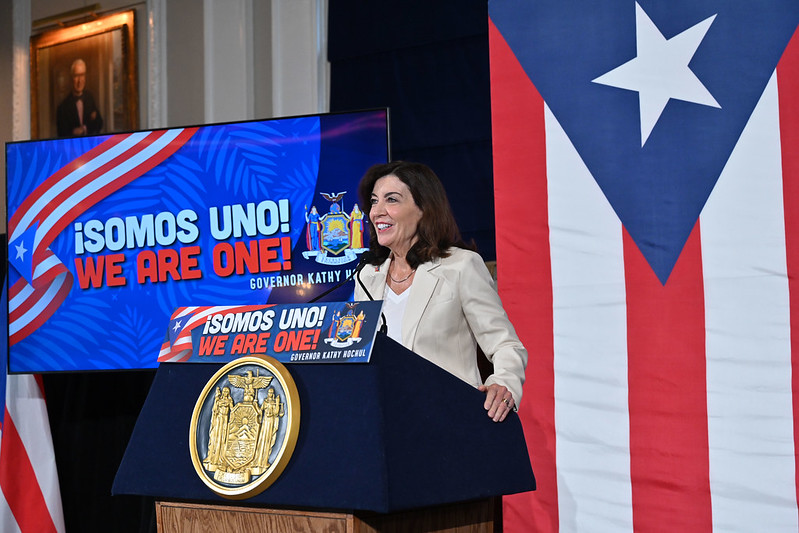
Gov. Hochul (photo: Kevin P. Coughlin/Office of Governor Kathy Hochul)
How several hundred Latino-majority election districts voted in the 2022 gubernatorial race between Democratic Governor Kathy Hochul and Republican Congressional Representative Lee Zeldin should prompt Democrats to pay more attention to Latino voters’ needs.
Perhaps the biggest finding is that Latinos—traditionally among the most loyal Democrats in the state—moved toward the Republican candidate. Though the movement is not large enough for Democrats to be alarmed, unless Democrats engage and invest resources in Latinos now, they can potentially see a much larger defection among Latinos.
Key findings of my new analysis of voter data by election district include:
-Turnout in 2022 increased by over 200,000 votes statewide compared to the previous gubernatorial general election in 2018, when Democratic Governor Andrew Cuomo fended off Republican County Executive Marc Molinaro’s challenge.
-Despite this statewide increase, New York City saw a 15% decline in voting participation (from over 2 million voters to just under 1.8 million). By contrast, many counties outside the city, like Nassau, Suffolk, and Erie, saw increases in voting participation compared to the previous gubernatorial election. The largest increase was seen in Erie, Governor Hochul’s home county.
-Statewide, Latino voting participation declined 19% from 2018 to 2022, with just under half-a-million Latinos going to the polls in 2022 (Estimates are based on my analysis of election results and the use of demographic modeling data.)
-The largest decline in Latino voting participation across overall was in New York City. Only 285,176 Latino voters cast a ballot, a 28% decline from 2018.
-Of the 285,000+ Latino voters who voted in New York City in 2022, 50% were registered Democrats compared to almost 60% in 2018, an almost 10% decline in voting participation among Latino Democrats in the city.
-Latino support in New York City for the top of the Democratic ticket declined by over 10% from 2018 to 2022. In majority Latino election districts across the city in 2018, support for Cuomo was 90-95%. Support for Molinaro registered below 5% in most of those districts. In 2022, support for Hochul in the same areas hovered between 78% and 82%. Roughly 20% of Latinos in these areas supported Zeldin.
What can we conclude from all this?
Latinos continue to support Democrats in large though decreasing numbers.
From 2018 to 2022 there was a significant decline in Latino voting participation in New York City, and an increase in Latino support for the Republican candidate for governor.
Yet that increase hardly signals a game-changing political shift in New York. We will need to wait until the 2024 election cycle for more clues about Latino voters’ participation and their party preference. We may see some indications via the 2023 New York City Council elections and public polling ahead of the real evidence in the 2024 elections.
So what factors prompt both a decline in voting participation and seemingly increased support for Republicans?
While the reasons behind this decline are complex, we do know that low voter turnout among Latinos is in part a direct result of lack of investment in and engagement of Latino voters.
Bernard Fraga, in his excellent data-driven book, The Turnout Gap, has observed that when political parties and candidates fail to engage Latinos, turnout lags. But intentional and strategic engagement efforts, tackling critical policy issues that affect Latino communities, and investing in the political empowerment of Latinos through the support and training of Latino candidates all remind Latinos of their value and importance in the political/electoral sphere.
Factors that led to a 28% decline in Latino voting participation in New York City include the Hochul campaign and the State Democratic Party relying on surrogates and TV and radio ads. This tactic does not work for Latinos, who respond better to personal contact and sustained engagement. In short, it is the bread-and-butter grassroots approach to campaigning that Latinos respond to more favorably, and which Hochul and the state party failed to do. Furthermore, a six-figure sum was a paltry investment in the State Democratic Party’s Nueva York Initiative—purportedly an effort to woo Latinos to the party of which Hochul is the de facto leader.
Back just before the 2022 general election, I warned, “She may win [Latinos’] vote, but it’ll likely be with a smaller margin than that of any of her Democratic predecessors.” This is exactly what transpired.
The shifts we are seeing in Latino voter preference are not significant enough to conclude that Latinos are on the verge of initiating a Republican wave, though some of the shifts could make the difference in select local races like for the State Legislature or City Council. But something is happening and our leaders need to pay attention.
Many Latinos feel that Democrats are abandoning them on issues like jobs, public safety, education, and affordable housing, and in terms of their presence in our communities. In the 2024 election cycle, will we see widespread Latino defection from the Democratic Party? Or will we finally see political parties make a real investment in Latinos?
***
Eli Valentin is a political analyst and author of the forthcoming book, Reinhold Niebuhr: A Political Life. On Twitter @EliValentinNY.
***
Have an op-ed idea or submission for Gotham Gazette? Email This email address is being protected from spambots. You need JavaScript enabled to view it.
Applying a Model That’s Worked to Tackle Our Homelessness Crisis
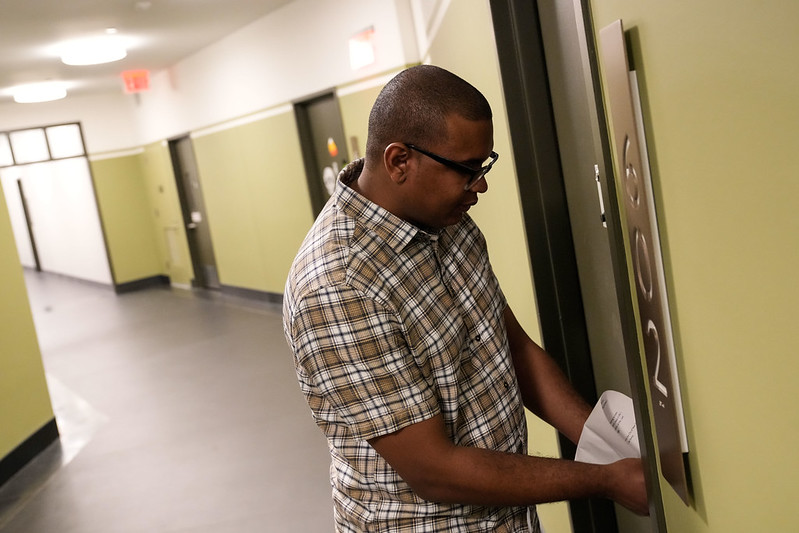
Heading home (photo: Michael Appleton/Mayoral Photography Office)
Solving a worsening homelessness emergency can feel impossible, but New York City already knows how to do it—and did it as recently as 2015 with military veterans.
Now, with the overall crisis reaching levels not seen since the Great Depression, New York should celebrate its success ending chronic veteran homelessness, re-examine what worked with that initiative, and apply it to the broader crisis. After all, it is an effective, proven way to ensure that every New Yorker has access to the housing they deserve.
It is useful to recognize just how successful that initiative has been for the city’s unhoused veterans. Despite the many endemic challenges facing returning servicemen and women, which often include lingering physical and mental health challenges from their service as well as struggles with substance abuse, New York City reduced veteran street homelessness by more than 98% from 2011 to 2020.
That is a remarkable achievement that didn’t happen by accident. And the good news is that we can do it again. In fact, the wheels are already in motion.
The initiative worked so well because the entire government ecosystem, from Washington D.C. to City Hall, prioritized getting veterans off the street. That level of support was crucial: it offered providers like us a broad toolkit to tackle the problem and solve challenges for veterans with unique needs.
One notable tool is the Rapid Re-Housing model, which aligns with the “Housing First” philosophy.
This intervention is primarily concerned with providing short-term rental subsidies and housing placement services to minimize the time clients spend homeless and to transition them quickly into permanent housing. In other words, the model centers permanent housing as the ultimate policy solution—a simple approach, but one that feels ambitious in a city that heavily relies on lengthy stays in shelter to manage homelessness.
Programs grounded in the “Housing First” philosophy—programs that do not mandate shelter stays or acceptance of services as a precondition to housing—can be truly transformative. As the homeless shelter population in New York City reached record heights in 2022 and continues to grow, this lesson was applied in a new pilot program with Volunteers of America-Greater New York (VOA-GNY) called Street to Home, which adopts the same “Housing First” philosophy that loomed large in the efforts to end veteran homelessness. Since September 2022, the program has helped 66 people get off the street and into a permanent home.
One of the greatest challenges to ending the cycle of homelessness is that individuals experiencing homelessness often cycle in and out of acute care facilities and have episodic encounters with mobile outreach and support services, but do not have the stable foundation of housing from which to rebuild their lives. The “Housing First” philosophy has been proven effective in ending chronic homelessness, also evident by its success with the veteran population, and is now helping more individuals experiencing homelessness access the services they need to get back on their feet through supportive housing.
But Rapid Re-Housing is not the only model that was central to the work of ending chronic veteran homelessness. That initiative showed the value of intervening at all points of the system, including before people even become homeless. Our Supportive Services for Veteran Families program provides prevention services to reach veterans at risk of homelessness and intervenes with an array of services, such as legal assistance and financial assistance, to prevent them from ever experiencing homelessness in the first place.
Unfortunately, there are limited resources available to expand the Rapid Re-Housing and prevention models beyond veterans, despite their proven track records. That should change, but it will require the same level of governmental support that was allocated to veterans—a population for whom there is significant political goodwill across party lines and levels of government.
While daunting, the veteran initiative is a proven model to emulate. The federal government stepped up and provided resources and funded new programs to reach veterans experiencing and at risk of homelessness. Now these programs should be scaled and made available to all. Everyone, across the government, non-profit, and private sectors should work together to provide our unhoused neighbors with the personalized, comprehensive care they deserve.
By following this model, New York can start to meaningfully address the homelessness crisis—just as it has done before.
***
Anddy Perdomo is Assistant Vice President, Veteran Services & Economic Empowerment Initiatives at Volunteers of America-Greater New York. On Twitter @VOAgny.
***
Have an op-ed idea or submission for Gotham Gazette? Email This email address is being protected from spambots. You need JavaScript enabled to view it.
New Yorkers Deserve a More Socially-Responsible Budget
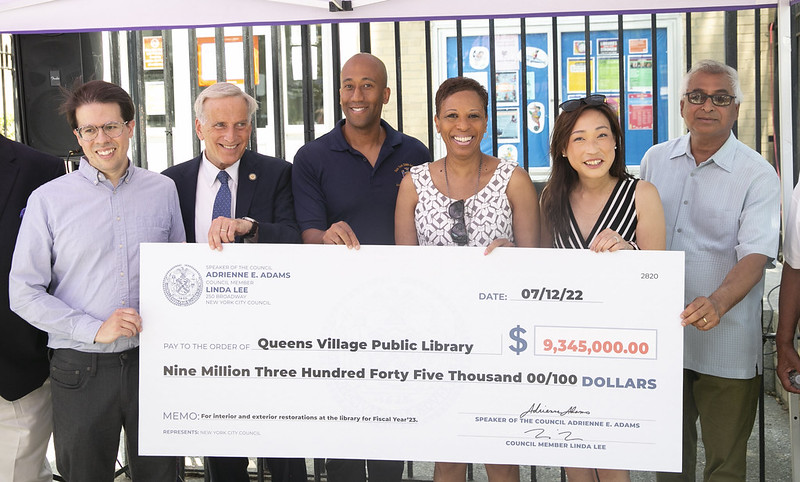
Library funding in hand (photo: John McCarten/NYC Council Media Unit)
As the New York City budget cycle ramps up, the need for near-term fiscal balance often leads to decisions that are costly, economically and socially, in the long run. Put another way, it’s generally cheaper to help than to harm, but the budget process is geared toward the latter. The extent to which this is avoidable in reality is open to debate. However, New Yorkers, as citywide investors, should have a publicly available tool to shed light on how these outcomes are affecting the overall well-being of the city and its residents.
Due to the complexity of the budgeting process in New York City, gauging such information is, at best, rather difficult and time-consuming. Budgetary analysis can be found in various reports by city entities, notably the Comptroller’s Office and the Independent Budget Office (IBO), as well as those by agencies, the City Council, and nonprofit groups. The challenge as an outsider looking at these many materials is that they are often overly-complicated, incomplete, or issue-specific – requiring labor intensive research to better understand the bigger picture across the vast array of city services.
A public communications approach along the lines of socially responsible investing (SRI), a strategy that works to generate both social change and financial returns, would afford New Yorkers a better sense of whether or not their tax dollars are being put to best use. It represents a shift from the current outlook, which strives to limit negative outcomes, by giving a sense of how strategic investments could produce more positive ones. The more comprehensive, economically-centered, easy-to-follow, and transparent the information is, the better.
To note, this idea differs to some degree from earlier discussions about linking the Mayor’s Management Report (MMR) to the budgetary framework. And instead of auditing the government to root out misuse or ineffective use of funds, it would work to define how current fiscal decisions will play out more broadly.
It would expand upon the forecasting over a five-year period that the IBO already does for the proposed budget by offering alternative scenarios, with defined assumptions about either additional social investment or lack thereof. It could also offer analysis for more extended time periods.
The idea is a clearer focus on making the best choices and investments to do the most good, while expanding the city’s economy, over time.
There are many issues where the city’s budget is short-sighted, missing the opportunity to create economic benefits, as well as often-intertwined social gains. Although these issues are complicated on many levels, a few are provided for context. Being able to capture them in a more collective socio-economic picture would be the overarching goal.
One is the exorbitant amount New York City spends to incarcerate people. In fiscal year 2021, the annual cost per detainee in city jails exceeded $550,000 per year, approximately 34 times what the city directly spends annually per public school pupil. With an average daily detainee population of about 5,500 people at Rikers, that’s over $3 billion spent per year. Since employment – in and of itself – is connected to a lower likelihood of incarceration, it can help reduce the number of at-risk individuals that wind up in the criminal justice system in the first place, and should thus be made more of a focus for investment.
For example, shifting more of this funding toward vocational training programs at a two-year cost of somewhere between $3,500 (public) and $15,000 (private/non-profit) per person seems to be a much better investment. The clean energy sector specifically is an area in need of trained workers for economic growth. At the statewide level, this sector rebounded faster than nearly all others from 2020 to 2021, and about 90% of employers who were hiring in 2021 found the process to be either ‘somewhat difficult’ or ‘difficult.’
The housing crisis is another area where such return-on-investment calculations arise. The primary cause of homelessness is lack of affordable housing, particularly among families. For example, in fiscal year 2022, stays in the city Department of Homeless Services (DHS) shelter system stays were, on average, 509 days (single adults), 534 days (families with children), and 855 days (adult families). Among many negative outcomes, being homeless makes it harder to find and maintain employment and complete one’s education. The city spends billions of dollars per year on the shelter system.
While the city’s fiscal year 2022 budget did include about $5 billion more over ten years ($22 billion total) for affordable and public housing, that falls short of the city’s affordable housing needs. It is also less than the $4 billion per year ($40 billion over ten years) Mayor Adams pledged to spend during his campaign, which is based in part on estimates of what’s needed by pro-housing and anti-homelessness advocates.
Sufficient funding for education is critical to the overall health of the New York City economy. In the upcoming fiscal year, Mayor Adams is proposing to halt an expansion of preschool for 3-year-olds (3-K). There are many benefits for children who attend public 3-K. Some include a 6% increased likelihood of graduating from high school compared to peers who do not attend, as well as increased rates of taking the SAT and college enrollment. The administration is citing decreased enrollment, but should more closely evaluate outreach efforts.
Reduced city funding for CUNY is also on the table. This is again short-sightedly tied to decreased enrollment, which the city should work to reverse through outreach and investment. A 2020 study found that six out of seven of CUNY’s community colleges (which receive half of their capital funds through the city) are among the top 10 nationwide in promoting social mobility, and its accompanying economic benefits. A separate study found that those with bachelor’s degrees contribute on average $278,000 more to their local economies than high school-only graduates through direct spending over the course of their lifetime.
Conversations about how to better include ‘social value’ in our efforts to address these kinds of issues have picked up steam in recent years. With respect to affordable housing, for example, bills are currently under discussion in the City Council under the social housing model, where housing could be built ‘for public good’ rather than profit. New Yorkers should be able to see – quantitatively and qualitatively – how this kind of outlook could work across a variety of issues. Such information can help shift the broader dialogue on how we currently make budgetary decisions, as well as shed light on those that all-too-often profit from maintaining the status quo.
Our current, short-sighted process often leads us to false choices and no easy way to evaluate their impacts. Providing the public with socially-responsible analyses would be in line with what many investors are now using to make financial decisions. After all, people who live, work, or just spend time and money in New York City are literally investing in the city itself.
It’s actually cheaper across many of our biggest city issues to help than to harm — but the fiscal analysis of these decisions must be done and shown far more robustly. In a town as financially-minded as New York City, we should be able to find a way to make better economic and social decisions. A good deal never hurts either.
***
Nancy Holt, PhD, leads Science for New York (Sci4NY), an effort that aims to have policymakers and scientists work more closely together through project-based interaction in New York City. On Twitter @Sci4NY.
***
Have an op-ed idea or submission for Gotham Gazette? Email This email address is being protected from spambots. You need JavaScript enabled to view it.
Protect New York City's Supportive Housing Providers in the Face of a Mounting Crisis
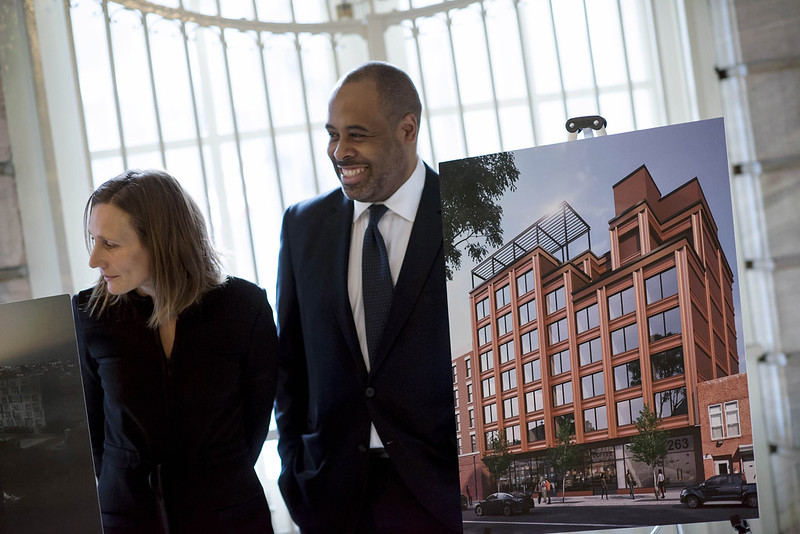
Housing at stake (photo: Ed Reed/Mayoral Photography Office)
New York City’s nonprofit supportive housing community, which has for decades successfully provided deeply affordable housing to formerly unhoused and low-income individuals, is increasingly endangered by New York’s mounting housing crisis.
Study after study has shown that supportive housing – a combination of affordable housing and voluntary services like case management and mental health and addiction counseling – is the most effective method to combat chronic homelessness and put people on the path to healthy, independent living. Maintaining that track record of success requires consistent funding, a well-trained and competitively compensated workforce, and a flexible and responsive continuum of care for tenants with the most acute needs.
As a form of independent rental housing – not a residential or treatment program – supportive housing tenants sign a lease upon moving in, which typically requires them to pay 30% of whatever income they have toward rent. This is in line with the federal affordability standard and is critical to support nonprofit providers’ financial solvency and their ability to provide vital services.
Operating on razor-thin margins, providers must rely on timely rent payments to keep the lights on and staff paid, and they partner with all levels of government to offer dramatically reduced rents to the households in most need.
Today, supportive housing and low-income tenants are struggling. It’s estimated that nearly one in three tenants in affordable housing owes back rent, adding up to nearly $2 billion in missing rent payments. More than 70,000 NYCHA tenants alone owe a total of $466 million in back rent. While NYCHA’s fiscal crisis has been widely reported, less attention has been given to the similar fate nonprofit housing providers face if relief from government partners is not provided.
In supportive housing, nonpayment of rent is one of the first indications that tenants may be in crisis. Good providers have layers of systems in place to help tenants get back on track. They collaborate with the onsite social service provider to problem solve - including creating manageable payment plans. This engagement often works, obviating the need for further action.
When tenants cannot or will not work with service providers, the only available option is applying for a “one shot deal” (OSD) from the city. This covers the amount tenants are in arrears so they can remain housed, and buildings can continue to operate. To apply for an OSD, tenants must file a cash assistance case with the Human Resources Administration (HRA). While it is not an official policy to have a Housing Court case to get an OSD, it is the experience of nonprofit providers that demonstrating imminent risk of eviction through a filed court case does support one’s chances of getting assistance.
The court proceedings that trigger the OSD approvals are often done with the tenant’s knowledge that the purpose is to ensure arrears are paid and they aren’t displaced. These proceedings almost never result in actual evictions.
It is unclear to what extent the recent addition of $391 million in state Emergency Rental Assistance Program (ERAP) funding will impact the existing need among supportive housing tenants.
Meanwhile, nonprofit supportive housing providers are doing whatever they can to cope with an avalanche of challenges. These include 30% staff vacancy rates as well as significantly increased tenant need. Adding massive rental arrears to their already precarious situations is putting providers – as well as their tenants - at serious risk.
Everything should be on the table to ensure providers are made whole and tenants stay housed. That includes examining a better process so formerly homeless tenants with significant arrears can quickly and seamlessly access the financial support they need. We understand and appreciate that HRA is willing to work with the supportive housing community on systemic fixes, which may include seeking changes to regulatory requirements that determine eligibility to improve this process.
At a time where the city’s shelter population is at unprecedented heights, we must protect existing housing for formerly homeless New Yorkers and build more of it. If we fail to act quickly, it will be difficult – if not outright impossible – for the city to successfully address its homelessness, mental health, and housing crises.
***
Pascale Leone is Executive Director of the Supportive Housing Network of NY. Catherine Trapani is Executive Director at Homeless Services United. On Twitter @theNetworkNY & @HSUNYC.
***
Have an op-ed idea or submission for Gotham Gazette? Email This email address is being protected from spambots. You need JavaScript enabled to view it.
I’ve Worked in Times Square for 18 Years; A Fresh Entertainment Destination – with Gaming – is the Change the Neighborhood Needs

Rendering of a proposed Times Square casino
In 1998, I started selling clothing at the corner of 45th and Broadway in the heart of Times Square. Back then, the neighborhood was chaotic, overwhelming, and a little bit scary. In the 2000s, the area was a target of global violence, as well: On May 1, 2010, a Nissan Pathfinder parked near my stand began emitting smoke. I joined a handful of other vendors in alerting the NYPD, who eventually found and disassembled an explosive device made up of two full 5-gallon cans of gasoline, three full 20-gallon propane tanks, and more than 250 pounds of fertilizer. Times Square – and all of New York – dodged a bullet that day.
Fast forward 13 years, and Times Square has undergone a remarkable transformation.
As I walk to my stand today, I can't help but marvel at how different the area looks and feels from when I first arrived. The quality of ground-level retail has also gone up dramatically. The iconic peep shows, once synonymous with Times Square, have given way to clothing stores, souvenir shops, and restaurants. A once-seedy portion of the city has become a family-friendly magnet for visitors.
Still, I can't help but feel that there is more work to be done. While the city's efforts to improve safety and security in Times Square have been commendable, there is still a sense of economic unease that lingers in the air. The two engines of Times Square’s economy have always been tourists and office workers, both of which were hampered significantly by the COVID-19 pandemic. Now, many of the tourists have returned, but the switch to hybrid work has left a real dent in the neighborhood.
In the midst of this uncertainty, I’m struck by the need for further development. The prospect of a once-in-a-lifetime entertainment destination opening in the area – Caesars Palace Times Square – is generating buzz, and for good reason.
Caesars’ proposal for a new gaming venue at 1515 Broadway, in partnership with real estate developer SL Green and Jay-Z’s Roc Nation, would bring a brand-new flagship to what is already New York’s best entertainment destination. This project would generate an influx of visitors, providing a much-needed boost to theaters, hotels, restaurants, and retailers in the area.
Caesars Entertainment, SL Green, and Roc Nation are also promising a multi-million-dollar investment in Times Square, including congestion mitigation efforts, improved safety, and better sanitation.
The impact of this partnership would extend far beyond the casino itself, benefitting the entire community and funding a wide range of neighborhood initiatives and improvements to make Times Square the safest, cleanest, and most pedestrian-friendly entertainment district in the world.
I have seen Times Square at its best and at its worst. A new, state-of-the-art entertainment destination like Caesars Palace Times Square is exactly the kind of innovative development that can keep the neighborhood on the right track. Times Square thrives on change, and this is the change that we need.
***
Duane Jackson is a vendor in Times Square.
***
Have an op-ed idea or submission for Gotham Gazette? Email This email address is being protected from spambots. You need JavaScript enabled to view it.
Civil Justice Reform Can Help Accomplish Progressive Goals
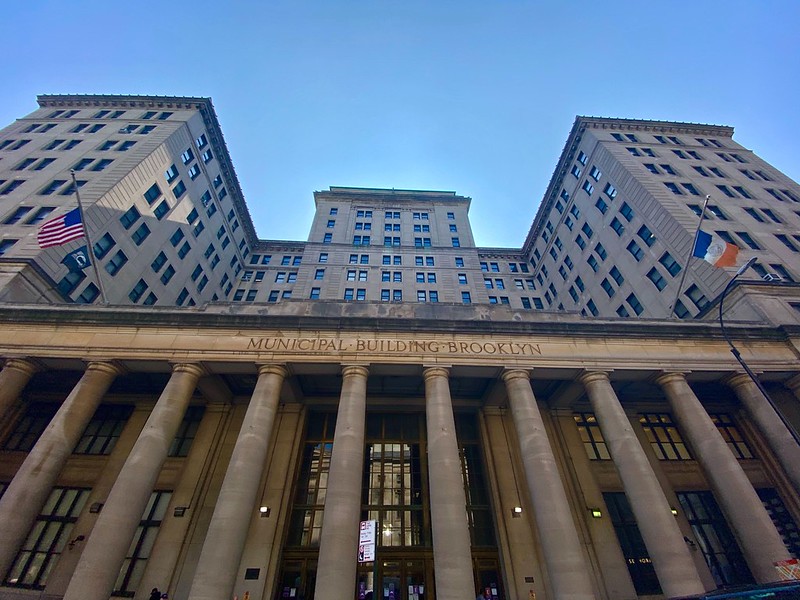
Municipal Building Brooklyn (photo: Michael Appleton/Mayoral Photography Office)
New York’s broken civil justice system is holding back progress.
Civil justice reform is often unfairly maligned. In reality, most common-sense legal reform initiatives align with progressive goals and values that benefit all New Yorkers.
Civil justice reform targets the financial incentives that often drive excess lawsuits. A relative handful of people currently abuse the civil justice system for economic gain. Lawyers rake in millions from the injured and most vulnerable members of our society. Personal injury firms advertise heavily on daytime TV, near construction sites, and even target emergency rooms with digital ads. According to a study published by the RAND Corporation, personal injury claims are disproportionately filed by residents of the poorest neighborhoods, with attorneys consistently taking 33% of every settlement.
Then there are the financiers, unregulated consumer lawsuit lending outfits and hedge funds that invest in lawsuits, turning the civil justice system into a tool for predatory lending. Interest rates on lawsuit loans have exceeded 100% interest and bankrolled some of the worst abuses of our civil justice system. In addition, these third-party lenders can drag out litigation, the judge and jury unaware that a third party is working behind the scenes. These practices incentivize speculative lawsuits that clog up the courts for those who really need them. Progressives seek to protect the vulnerable. Regulating predatory lawsuit lending would be a good place to start.
Due to our liability system, New York is the most expensive place to build on the planet. The state’s unique Scaffold Law, dating back to the 19th century, holds property owners and contractors 100% liable for any injuries sustained on job sites, even when they were not primarily at fault. With money and resources tied up in liability, investments aren’t made in progressive goals like repairing and updating schools, building affordable housing, or expanding wind, solar, and other renewable energy sources.
Any person or business causing harm to others should be held accountable, but due to our permissive laws, profit-seeking lawyers often target innocent people. If someone trespasses on private property, breaks the law, and injures themselves, the property owner will likely get slapped with a lawsuit. There must be changes made to the law prohibiting trespassers from suing for injuries sustained while trespassing, but we should also ensure that these reforms – which would reduce expensive lawsuits that increase homeowners’ insurance and costs to municipalities – also protect children. This includes children who may have found the neighbor’s unsecured swimming pool appealing and children hurt due to homeowners’ negligence.
A truly progressive state must have affordable and equitable health care in all communities. In New York, the threat of baseless medical liability lawsuits has driven doctors out of our state and contributed to the nursing shortage crisis. Fewer doctors threaten access to care for our most vulnerable communities. Doctors worry that just practicing in places like the Bronx can “destroy their careers.”
Even when medical care is accessible, it is wildly expensive, due in large part to liability costs. New York has the country's highest medical liability payout costs, both overall and per capita. And some legislative proposals could make the situation worse. This is both expensive for patients and makes it difficult for New York to attract the best doctors.
The core of our civil justice system is to protect individuals and ensure the scales of justice remain balanced. Common sense legal reforms will prevent unnecessary lawsuits, reduce medical costs, improve access to the courts and medical care, and help us build more affordable housing and realize the state’s renewable energy goals. The current system is weighted towards wealthy and politically connected lawyers. It needs to work for the rest of us.
***
Ruvi Lopez is grassroots manager at the Lawsuit Reform Alliance of New York. On Twitter @LawsuitReformNY.
***
Have an op-ed idea or submission for Gotham Gazette? Email This email address is being protected from spambots. You need JavaScript enabled to view it.
End Legacy Admissions, Ensure More Fair College Acceptance in New York
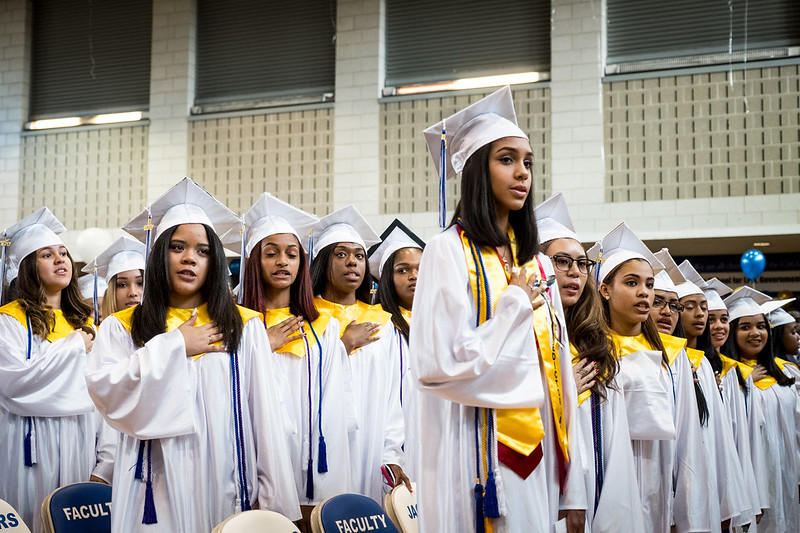
Heading to college (photo: Edwin J. Torres/Mayoral Photography Office)
Last year, the Supreme Court heard arguments in two cases that could fundamentally change how colleges offer admissions to historically disenfranchised students. A group called Students for Fair Admissions filed suit against Harvard University and the University of North Carolina, challenging the use of race as one measure of a prospective student’s application for admission. The group argued that any consideration of race, even if non-dispositive, is unconstitutional. Most legal experts predict that the conservative majority on the Supreme Court is likely to agree.
Ensuring that historically marginalized students can receive the same opportunities as privileged students is incredibly important. Just 27% of Black and 20% of Hispanic adults living in New York City have a bachelor’s degree, compared to 45% of Asian and 64% of white residents.
While the Students for Fair Admissions cases are grabbing lots of headlines, there are actually more pernicious admissions practices that make it more difficult to ensure every student has equal access and opportunity to pursue higher education. The real culprits of fair college admissions are practices such as legacy preference and binding early-decision admissions that effectively work as a form of affirmative action for privileged students, who are allowed to take spots at selective colleges from equally (or more) qualified students of color and first-generation college applicants.
For years colleges have given the family of alumni an advantage when they apply for admission, which they claim fosters a sense of “community and tradition” on campus, or that it helps raise money for their endowments. In truth, legacy preferences just favor wealthy, more privileged, and predominantly white families that have lived in the United States for generations and benefited from past exclusionary and discriminatory policies.
More than 70 colleges in New York provide a legacy preference. Worse yet, more than a third of our public universities consider an alumni relation relevant in admissions. Almost none of New York’s colleges publish data on how many legacies they enroll each year. The data we have, however, shows the disturbing extent to which legacy preferences undermine racial diversity at New York colleges.
Nearly a quarter of New York residents are immigrants and almost one-fifth are native-born citizens with at least one immigrant parent. This anachronistic policy of “legacy preference” shuts the door on many of these potential applicants, who may be the first in their family to go to college.
Likewise, early-decision admissions, which allow students to apply early to one school and commit to attending if accepted, is an equally, if not more exclusionary, practice. Forty-five New York colleges and universities offer an early decision option. Applying early-decision requires know-how and money, which may be why students attending private high schools are more than three times as likely than public school students to apply early decision. A student applying early is at a competitive advantage relative to other applicants because colleges and universities set aside a significant number of seats for early applicants, and those students who apply must be financially prepared to enroll if accepted without being able to consider financial aid offers.
What this means is that students without wealth and strong college counseling — students who disproportionately are Black, Hispanic, low-income, and/or first-generation — are likely to be at a disadvantage for early decision programs. You don’t need any more proof than this: applicants from the wealthiest ZIP codes in the United States were twice as likely to apply early decision than all other applicants.
Legacy preferences and early-decision admissions policies are by their very definition exclusionary practices that harm students without access to privilege and wealth. That’s why we introduced the Fair College Admissions Act, which would prohibit the use of legacy preference and early-decision in all colleges in New York, public and private. Schools that continue to use these exclusionary practices would be assessed a penalty equal to 10% of their tuition revenue, which would then be used to bolster the state’s Tuition Assistance Program (TAP), which provides financial assistance to students of lesser financial means.
This idea should not be radical. In 2021, Colorado became the first state to ban legacy preferences in college admissions. And in recent years more than 100 public and private schools have voluntarily done the same, including Amherst College, California Institute of Technology, Pomona College, and Johns Hopkins University. Unsurprisingly, the sky did not fall and these institutions continue to thrive.
Given the Supreme Court’s expected decision in the Students for Fair Admissions cases, New York and the higher education institutions that call this state home can take bold action to dismantle the systems and traditions that bar underprivileged students from pursuing educational opportunity by enacting the Fair College Admissions Act and living the values of equitable inclusion that makes our diverse state so great.
***
State Senator Andrew Gounardes and Assemblymember Latrice Walker each represents parts of Brooklyn. On Twitter @Sen_Gounardes & @TheRealLatriceW.
***
Have an op-ed idea or submission for Gotham Gazette? Email This email address is being protected from spambots. You need JavaScript enabled to view it.
Jordan Neely, the Social Safety Net, and Blaming the Victim
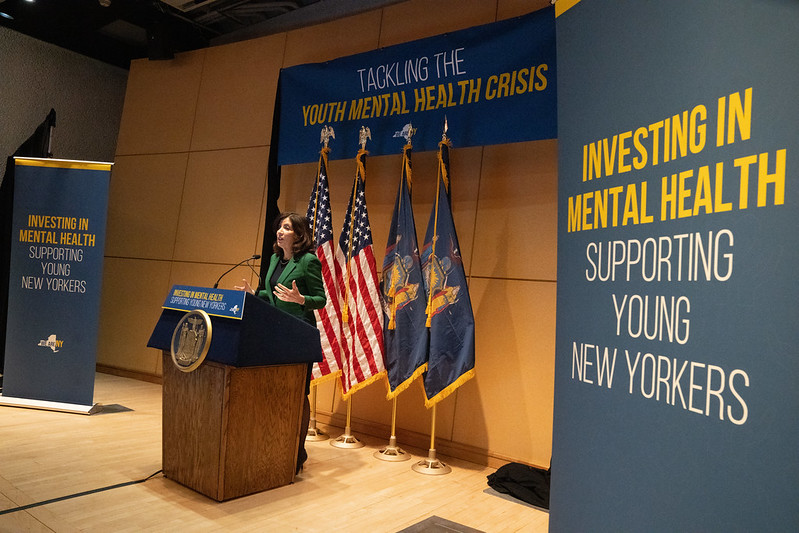
Gov. Hochul talks mental health care (photo: Don Pollard/Governor's Office)
The often competing interests of public safety and compassion toward individuals experiencing homelessness again collided violently in New York City. Jordan Neely, 30, a Black, homeless man, was fatally subdued on the subway recently by a young white former Marine named Daniel Penny.
Some consider Mr. Penny a hero; others refer to him as a racist vigilante who put Mr. Neely into a chokehold until death. Many reference Mr. Neely’s history of arrests, erratic behavior, and reports of autism and substance use.
I see yet another example of a phenomenon called “blaming the victim.”
My experience as a disability advocate assisting chronically homeless individuals in New York State leaves me wondering why the homeless services system manages to emerge relatively unscathed whenever high profile incidents like this occur.
If a municipal authority, social services official, or nonprofit organization makes a statement about such an incident, it is usually prefaced with “He didn’t” or “She wouldn’t” or “They refused.” We have been conditioned to believe that homeless individuals are “services resistant.” Yet in my work with this challenging population, I have rarely met anyone who didn’t want a clean, safe home.
It is beyond time to examine key factors that relate to our ongoing crisis.
Approximately one third of the homeless population is disabled with cognitive impairments, psychiatric disorders, traumatic brain injuries, and often related substance use disorders. Nearly every disabled individual whom I’ve assisted had been kicked out of shelters for “noncompliance” with extensive rules with which they could not comply. For example, a nearly blind man with a brain injury was required to sign many pages of rules without assistance or eyeglasses to stay in a shelter.
Mr. Neely reportedly experienced a psychiatric disorder, autism, and a substance use disorder. He was at high risk of death on the streets and was on the “Top 50” list of people outreach workers viewed as most in need of assistance. He had been brought to hospitals voluntarily and involuntarily.
We are relying upon an antiquated shelter system. Many shelters require residents to leave during the day, while others can be so unpleasant that residents prefer to leave. This forces libraries, gas stations, transportation systems, churches, and parks to accommodate their needs, thereby exacerbating their challenges and the homeless visibility issues that concern neighbors, commuters, and tourists.
Lacking a permanent address, homeless individuals who encounter problems with the law often don’t receive notices of court dates. Then, when arrest warrants are issued, they avoid shelters and soup kitchens where warrants may be served.
Mr. Neely reportedly had been arrested over 40 times. Numerous arrests for misdemeanor offenses may have been unavoidable, like public urination and trespassing. A warrant was issued for Mr. Neely’s arrest in February; notably, he referred to being hungry, thirsty, and tired on the subway prior to his death and indicated that jail may be a place he could get his basic needs met.
Some individuals whom I’ve assisted were treated with astonishing cruelty by homeless services personnel unqualified to work with psychiatric and neurocognitive disorders. This is a significant reason why people exit services.
There are immediate steps that we can take to improve conditions.
Register all disabled homeless individuals in New York State for Medicaid. This will offer access to physicians and rehabilitation specialists who can provide expert diagnoses, so we no longer need to rely upon the opinions of homeless services personnel, outreach workers, and police.
Identify those at highest risk of death; house them and all individuals on the “Top 50” list in single-room accommodations. They should receive medical and legal services coordinated by a disability advocate who accompanies each person to all appointments. This is how I assisted all of my people into permanent housing. It works.
Develop a strong appeals process to reduce evictions from shelter.
Provide places for people to go - daytime drop-in locations equipped with computers, WiFi, TVs, beverages, and snacks, where people can also nap safely.
Stop blaming the disabled victims of a flawed homeless services system.
Vehemently denounce violence against homeless individuals.
Help is on the way.
Ten years ago, President Obama launched The BRAIN Initiative (Brain Research through Advancing Innovative Neurotechnologies). This project is generating fascinating insights into new treatment options for brain-related disorders. Recently, President Biden launched The White House Report on Mental Health Research Priorities, a federal initiative to study mental health issues intensively. These resources can guide us as we continue to navigate the challenges that psychiatric and neurocognitive disorders present, including within the homeless population.
In the meantime, let us utilize those evidence-based practices that we know do work to help those experiencing homelessness. Sweeps, criminalization, court orders, and policing are not solutions. New York has led the nation in continuously affirming a right to shelter. We must continue our leadership by spearheading a path toward the compassionate and humane provision of permanent, appropriate, supportive housing for all in need.
***
Dr. Mary McLaughlin, PhD, is an advocate and researcher focused on disability and homelessness.
***
Have an op-ed idea or submission for Gotham Gazette? Email This email address is being protected from spambots. You need JavaScript enabled to view it.




